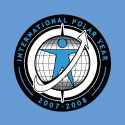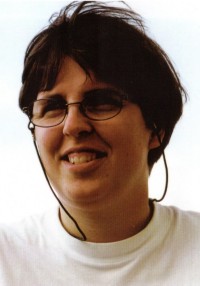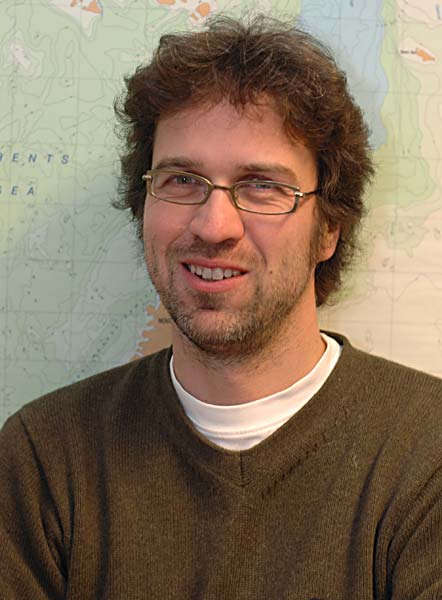


Eiliv Larsen, geologist is employed as scientist with the Geological Survey of Norway. He also has an adjunct position as professor with the University of Bergen. Eiliv is project leader for SciencePub, and will together with all co-workers, guide the project to success both in terms of science and public outreach. His research contributions in the project are within the fields of glacial and lake history, and sea-level changes. Most of these investigations take place in Russia.

Gudmund Løvø is a journalist and an information officer at the Geological Survey of Norway (NGU). He directs the public outreach efforts in the project (module 5 leader). Together with information officers from all the collaborating institutions, he will work for the project to reach a broad public. Keywords are popularising, exhibitions and contact with the media. The public outreach group also coordinates the activity concerning journalist students at fieldwork.

Maria Jensen is a geologist and associate professor at the University Centre in

Astrid Lyså, geologist is employed as scientist at the Landscape and Climate Team, Geological Survey of Norway. Astrid contributes to the SciencePub project through research on glacial history and environmental changes related to variability in climate, drainage and sea level in the last ca. 130.000 years. The investigations take place mainly in Russia. Astrid will also contribute to combine our results of environmental changes since the last glaciation with archaeological records of early human colonization and adaptions of northern Fennoscandia

Kari Grøsfjeld is specialized within dinocyst analysis. This is a palynological method to reconstruct climate changes and interaction between different waters. The water characteristics, phytoplankton productivity and the distribution of dinocysts in the modern sediments in the region inshore and offshore Svalbard are investigated, which is critical for understanding the dynamics between the hydrography and phytoplankton production in the Arctic. In the SciencePub project the dinocyst data will be used as a basis for developing a tool to reconstruct climate parameters.

Ola Fredin is a Quaternary Geologist/Physical Geographer working at the Geological Survey of Norway. Ola contributes to the SciencePub project by mapping landforms and deposits from the Quaternary ice sheets in Russia. His main tools are remote sensing data (satellite images) and high quality digital elevation data. By using these tools we can map vast areas in relatively short time and get a consistent view of the whole field area.
Haflidi Haflidason is geologist and professor in marine geology at the University of Bergen, Department of Earth Science. Haflidi contributes to the SciencPub project through research on tephra layers in both the marine cores from the N-Norwegian Sea and glacial lake basins from Russia. The tephra studies will focus on a few known large volcanic eruptions known to have taken place during the last ca. 130.000 years. The main objective will to link the marine and the land archives with a high precision by using the tephra layers as an instantaneous timeline.


Igor N. Demidov is a geologist and leader of the palaeoecolocical laboratory at the Russian Academy of Sciences, Karelian Research Centre (K RAS). Igor's research contributions in the project are within the fields of glacial and lake history, and sea-level changes. These investigations take place in Russia. Additionally, Igor is a key person in a number of ways regarding practical aspects of carrying out expeditions in Russia.
Katrine Husum is geologist and research scientist at the Department of Geology, University of Tromsø. She works with module 1 ”Climate proxies” and module 3 ”Ocean – ice sheet interaction: Ocean climate variability”. She will develop methods to reconstruct climate parameters from the ocean and investigate variations of ocean and climate the last ca. 130.000 years. The investigations are carried out in the seas north of 70°: Fram Strait, Nordic Seas, and the Barents Sea.

Dorthe Klitgaard Kristensen is a geologist and specialist on a group of microfossils called foraminifera. She is employed as a researcher at the Norwegian Polar Institute, Tromsø. In SciencePub she is leading module 1 that aims at developing and improving methods for reconstructing climate parameters back in time by the use of different types of marine microfossils and tidal deposits on land. She also contributes with reconstructions of variations in the ocean currents around Svalbard through the last 15.000 years by using the content of microfossils (foraminifera) in marine sediment cores. Together with other researchers in SciencePub who study other types of marine microfossils in sediment cores detailed knowledge can be obtained on the variations in ocean currents and sea-ice conditions back through time.

Jon Landvik is professor of Quaternary geology at the Norwegian University of Life Sciences (UMB) at Ås. He is the leader of SciencePub Module 2: Ice sheet-ocean interaction: Ice sheet variability. Jon has a research background from studying the last interglacial/glacial cycle in the circum North Atlantic region (Norway, Svalbard and Greenland) based on land stratigraphic and geomorphologic studies. In SciencePub, he and the UMB group will focus on the past glacial events on the west coast of Svalbard and their correlation to the marine record.

Hans Peter Blankholm is professor of archaeology at the Institute of Archaeology, the University of Tromsø, Norway. He is the leader of SciencePub's Module 4 on the early human, postglacial colonization and adaptation in northern Fennoscandia. A Ph.D. student will be attached to the module. Together with Astrid Lyså he will co-ordinate and couple the invistigations of Modules 2 and 3 with the investigations of the pioneer colonization and adaptation. Field work will take place in Finnmark county.

Renata Viola is a geologist with an MSc in mineralogy and geochemistry. She worked from 1995 to 2000 as a consultant-engineering geologist, before acting as secretary of the Western Cape Branch of the Geological Society of South Africa. After moving to Norway, she has worked at the Geological Survey of Norway as a scientist in the hydrogeology group before taking up a position in the Landscape and Climate group. She currently acts as project coordinator and web administrator for SciencePub.





Atle Kjærvik is director of the Science Center in Trondheim. Together with Gudmund Løvø and other information officers from all the collaborating institutions, he will contribiute to the outreach phase of Science Pub. Keywords are popularisation and interactive exhibitions.
Bryan Hood is a professor of archaeology at the Institute for Archaeology, University of Tromsø. He is participating in Module 4 on early post-glacial human settlement and adaptation in northern Fennoscandia.
Tine L. Rasmussen is a professor in marine geology at the Department of Geology at the University of Tromsø. She is associated to the SciencePub-project and works with rapid climate changes during the last ice age. She analyses stable isotopes, foraminifera faunas and ice rafted debris in marine deposits from the Svalbard slope and shelf areas. The main purpose is to study the causes behind the high-magnitude and abrupt climatic and oceanographic changes in the past.

Tove Marienborg is director of the Science Center in Tromsø. Together with other information officers from all the collaborating institutions, she will contribiute to the public outreach side of Science Pub. Keywords are popularisation and interactive exhibitions.
Helena Alexanderson is a geologist with a background in glacial geology and luminescence dating from Scandinavia, Greenland and Siberia. She is employed as a post-doc at the Norwegian University of Life Sciences (UMB) at Ås. Together with the UMB-group, Helena works with the stratigraphy and chronology of the coastal deposits on western Svalbard within module 2 of SciencePub.



Heidi T. Ryen is a PhD-student at

Jochen Knies is a marine geologist and currently the teamleader for Landscape and Climate development at the Geological Survey of Norway. In the SciencePub prosjekt he will be working with the deglaciation history of the Barents Sea based on organo-geochemical and sedimentological proxies (Module 3). Together with Morten Hald, he will be supervising a PhD project within SciencePub
Mona Henriksen is an assistant professor in Quaternary geology at the

Aurélien van Welden is geologist post-doc fellow in Geological Survey of Norway. He works on the sedimentary record of Quaternary environmental changes, using both fieldwork (including high resolution acoustic imagery) and labwork approaches such as sedimentary fabric characterization (e.g. grain size evolution) or sediment mineralogy (X-Ray diffractometry, geochemistry, magnetic properties…). He participates in SciencePub to the study of glacio-fluvio-lacustrine deposits related to climate change during the Late Quaternary.


Lena Rubensdotter is a physical geographer/quaternary geologist working with landscape and paleoclimate reconstructions based on geomorphology and lake sediment analysis. She works at NGU, Trondheim as a postdoc in the Landscape and Climate/Geohazard groups. In SciencePub she is working with reconstructions of glacial history in Russia based on geomorphology and she is also involved in the public outreach module 5 through the SPOR-exhibition.